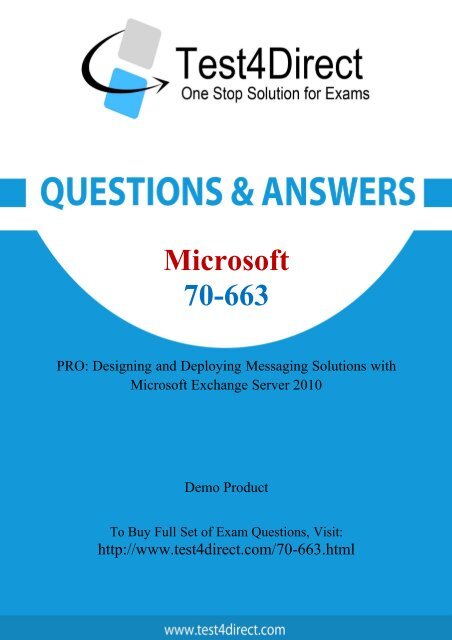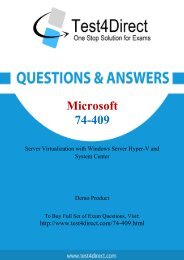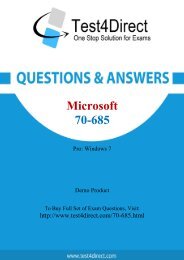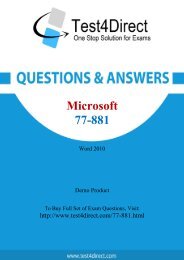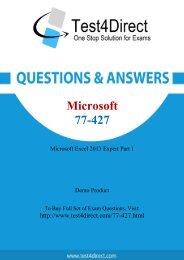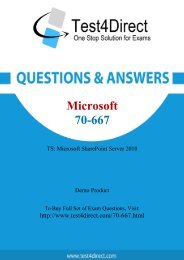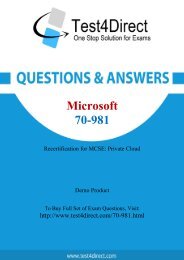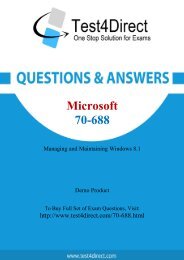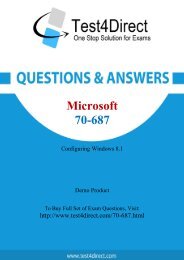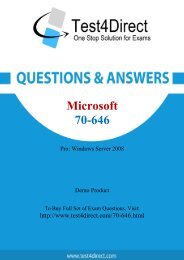You also want an ePaper? Increase the reach of your titles
YUMPU automatically turns print PDFs into web optimized ePapers that Google loves.
Microsoft<br />
<strong>70</strong>-<strong>663</strong><br />
PRO: Designing and Deploying Messaging Solutions with<br />
Microsoft Exchange Server 2010<br />
Demo Product<br />
To Buy Full Set of Exam Questions, Visit:<br />
http://www.test4direct.com/<strong>70</strong>-<strong>663</strong>.html
Question: 1<br />
Your network contains an Active Directory forest that has a single domain. You have an Exchange<br />
Server 2010 organization. You plan to add a new domain to this Active Directory forest and deploy<br />
Exchange Server 2010 servers in the new domain. A user named Admin1 is a member of this Active<br />
Directory group named Organization Management. Admin1 will deploy the Exchange new domain.<br />
You need to identify the minimum permissions required to allow Admin1 to install Exchange Server<br />
2010 servers in the new domain. Which group should you add Admin1 to?<br />
A. Domain Admins<br />
B. Enterprise Admins<br />
C. Exchange Install Domain Servers<br />
D. Server Operators<br />
Question: 2<br />
Question: 3<br />
Answer: C<br />
Your company has a Exchange Server 2010 organization. You plan to deploy Microsoft Office Outlook<br />
and mobile devices for remote users. You need to plan the deployment of Client Access servers to<br />
support the automatic configuration of Outlook profiles and --------. What should you include in the<br />
plan?<br />
A. Autodiscover<br />
B. MailTips<br />
C. Remote Access Server<br />
D. Unified Messaging auto attendant<br />
Answer: A<br />
Your network contains an internal network and a perimeter network that are separated by firewall.<br />
The perimeter network ___________ Server 2010 Edge Transport server. You plan to deploy an<br />
internal Exchange Server 2010 organization that meets the following requirements.<br />
• Support EdgeSync synchronization<br />
• Support encrypted delivery of outbound e-mail messages to the Edge Transport server<br />
•Minimize the attack surface of the internal networkWhich TCP ports should you allow from the<br />
internal network to the perimeter network?<br />
A. 3309 and 25<br />
B. 3309 and 636<br />
C. 50636 and 25<br />
D. 50636 and 135<br />
Answer: C
Explanation:<br />
LDAP: Port 50389/TCP<br />
Secure LDAP: Port 50636/UDP<br />
SMTP: Port 25/TCP<br />
Optional: enable RDP: Port 3389/TCP<br />
Question: 4<br />
Your network consists of a single Active Directory site. You plan to deploy Exchange Server 2010. You<br />
need to plan the deployment of Exchange Server 2010 servers to meet the following requirements:<br />
• All Mailbox servers must belong to a database availability group (DAG)<br />
• MAPI connections from Outlook clients must be load balanced by using a hardware load balancer<br />
• If a single server fails, users must continue to send and receive e-mail<br />
• The plan must minimize the number of server deployed<br />
What should you include in the plan?<br />
A. Deploy two servers.<br />
On the two servers, deploy the Mailbox server role, the Client Access server role, and the Hub<br />
Transport server role.<br />
Configure a Client Access server array.<br />
B. Deploy two servers.<br />
On the two servers, deploy the Mailbox server role, the Client Access server role, and the Hub<br />
Transport server role.<br />
Enable Outlook Anywhere on both Client Access servers.<br />
C. Deploy four servers.<br />
On two of the servers, deploy the Mailbox server role and the Hub Transport server role.<br />
On the other two servers deploy the Client Access server role.<br />
Configure a Client Access server array.<br />
D. Deploy four servers.<br />
On two of the servers, deploy the Mailbox server role.<br />
On the other two servers, deploy the Client Access server role, and the Hub Transport server role.<br />
Enable Outlook Anywhere on both Client Access servers.<br />
Question: 5<br />
Answer: A<br />
You have an Exchange Server 2010 organization that contains multiple Hub Transport servers. You<br />
need to recommend a message hygiene solution to meet the following requirements:<br />
• Block servers that are known to send spam<br />
• Minimize administrative effort<br />
What should you recommend?<br />
A. an IP Block list<br />
B. IP Block list providers<br />
C. recipient filtering<br />
D. sender filtering<br />
Answer: B
Explanation:<br />
IP Block List Providers are part of the connection filtering feature in Exchange. When the IP Block List<br />
Providers feature is enabled on a computer, the Connection Filter agent queries the specified IP<br />
Block List provider services to determine if the messaging server that has initiated the connection is<br />
a host that is known to send spam.<br />
http://technet.microsoft.com/en-us/library/dd351199.aspx<br />
Question: 6<br />
Your network contains two Exchange Server 2010 Edge Transport server and five Exchange Server<br />
2010 Hub Transport servers. All e-mail sent from your organization to the Internet is transferred by<br />
the Edge Transport servers. You need to recommend a security solution for the organization to meet<br />
the following requirements:<br />
• Ensure that users can send encrypted messages to any other organization on the Internet<br />
• Ensure that all Exchange related communication between Hub Transport servers and Edge<br />
Transport servers is encrypted.<br />
What should you recommend?<br />
A. Deploy IPsec.<br />
B. Deploy SMTP over SSL.<br />
C. Implement Domain Security.<br />
D. Implement Security/Multipurpose Internet Mail Extensions (S/MIME)<br />
Question: 7<br />
Answer: D<br />
Explanation:<br />
S/MIME provides a consistent way to send and receive secure MIME data. Digital signatures provide<br />
authentication, message integrity, and non-repudiation with proof of origin. Encryption provides<br />
data confidentiality. Compression can be used to reduce data size.<br />
http://www.networksorcery.com/enp/data/smime.htm<br />
Your company has two data centers. Each data center contains a perimeter network.<br />
Your network contains an Exchange Server 2010 organization.<br />
You plan to deploy Exchange Server 2010 Edge Transport servers in the perimeter networks.<br />
You need to recommend a solution for the Edge Transport servers that meets the following<br />
requirements:<br />
• Distributes inbound email messages across all Edge Transport servers<br />
• Ensures that users receive inbound e-mail messages if an Edge Transport server fails<br />
• Ensures that users receive inbound e-mail messages if a single data center network becomes<br />
unavailable<br />
• Minimize costs<br />
What should you recommend?<br />
A. In each perimeter network, deploy one Edge Transport server. Implement fallover clustering.<br />
B. In each perimeter network, deploy two Edge Transport servers. Implement fallover clustering.<br />
C. In each perimeter network, deploy one Edge Transport server. Configure a mail exchange (MX)<br />
record for each server.
D. In each perimeter network, deploy two Edge Transport servers. Configure a mail exchange (MX)<br />
record for each server.<br />
Question: 8<br />
Question: 9<br />
Answer: C<br />
Your company has an Exchange 2010 organization that contains multiple Hub Transport servers. You<br />
have a line of business application that retry e-mail messages by using a Hub Transport server named<br />
Hub1. The application only supports sending e-mail to a single SMTP server. You need to ensure that<br />
the application can retry e-mail messages of Hub1 fails. What should you do?<br />
A. Implement log transactions<br />
B. Install and configure failover clustering on the Hub Transport servers.<br />
C. Implement Windows network load balancing on the Hub Transport servers.<br />
D. Create multiple MX records for the Hub Transport servers in the internal DNS zone.<br />
Question: 10<br />
Answer: C<br />
Your company has a main office and a branch office. An Active Directory site exits for each office. The<br />
offices are connected by a WAN link. You plan to deploy Exchange Server 2010 in each site. You need<br />
to identify the number of Exchange servers required to meet the following requirements:<br />
• Maintain user access to mailboxes if a single server fails<br />
• Use the minimize account of Exchange servers in each site<br />
How many servers should you deploy in each site?<br />
A. 1<br />
B. 2<br />
C. 3<br />
D. 4<br />
Answer: B<br />
You have an Exchange Server 2010 organization. The organization has a Hub Transport server that has<br />
anti-spam agents installed. You plan to delegate the administration of the organization to a group<br />
named Security Administrators. You need to ensure that members of Security Administrators can<br />
manage anti-spam setting in the organization. The solution must minimize the amount of<br />
permissions assigned to Security Administrators. Which management role group should you assign?<br />
A. Hygiene Management<br />
B. Organization Management<br />
C. Records Management<br />
D. Server Management<br />
Answer: A
Explanation:<br />
The Hygiene Management management role group is one of several built-in role groups that make<br />
up the Role Based Access Control (RBAC) permissions model in Microsoft Exchange Server 2010. Role<br />
groups are assigned one or more management roles that contain the permissions required to<br />
perform a given set of tasks. The members of a role group are granted access to the management<br />
roles assigned to the role group. For more information about role groups, see Understanding<br />
Management Role Groups. Users who are members of the Hygiene Management role group can<br />
configure the antivirus and anti-spam features of Exchange Server 2010. Third-party programs that<br />
integrate with Exchange 2010 can add service accounts to this role group to grant those programs<br />
access to the cmdlets required to retrieve and configure the Exchange configuration.<br />
http://technet.microsoft.com/en-us/library/dd776125.aspx<br />
Question: 11<br />
Your company has three offices. An Active Directory site named Site1, Site2 and Site3 exists for each<br />
office. You have an Exchange Server 2010 organization. You deploy Exchange Server 2010 server 2010<br />
servers in Site1. You plan to deploy Exchange Server 2010 servers in Site2 and Site3. You need to<br />
recommend a solution that allows the Exchange Server 2010 servers to connect with the Exchange<br />
Server 2003 servers. You must meet the following requirements:<br />
• All e-mail messages that are sent to mailboxes on Exchange Server 2003 servers from mailboxes on<br />
Exchange Server 2010 servers delivered directly from a server in Site2.<br />
• All e-mail messages that are sent to mailboxes on Exchange Server 2010 servers from mailboxes on<br />
Exchange Server 2003 servers delivered directly to a server in Site1.<br />
What should you recommend?<br />
A. Create two SMTP connections and one Active Directory SMTP site link.<br />
B. Create a new routing group connector and modify the default routing group connector.<br />
C. Create an X400 connector to Site1 and modify the cost value for the default routing group<br />
connector.<br />
D. Move all Exchange Server 2003 servers and Exchange Server 2010 servers to a single routing<br />
group.<br />
Question: 12<br />
Answer: B<br />
Explanation:<br />
To coexist with Exchange server 2003 your Exchange 2010 servers must use the Exchange 2003 as a<br />
bridgehead. This will require a new routing group connector on the Exchange 2003 Servers<br />
You have an Exchange Server 2003 organization. All e-mail messages sent to the organization from<br />
the Internet are delivered to an Exchange Server 2003 server. You plan to transition the delivery of e-<br />
mail from the Internet to an Exchange Server 2010 Hub Transport server. You need to create a<br />
transition plan for e-mail delivery from the Internet. What should you plan to modify?<br />
A. accepted domains<br />
B. address lists<br />
C. e-mail address policies<br />
D. Recover connectors
Answer: A<br />
Question: 13<br />
You have an Exchange Server 2010 organization. The organization contains a Mailbox server named<br />
Server1. Server1 hosts two mailbox databases and one public folder database. You plan to deploy a<br />
new Mailbox server named Server2. You need to recommend a high-availability solution for Server1<br />
that meets the following requirements:<br />
• Mailboxes and public folders must be available if a single Mailbox server fails<br />
• Deploy the minimum number of servers<br />
What should you recommend?<br />
A. Install fallover clustering on both servers, and then configure cluster continuous replication.<br />
Replicate all public folders to Server2.<br />
B. Create and configure a database availability group (DAG).<br />
Add Server1 and Server2 to the DAG. Create database copies.<br />
Replicate all public folders to Server2.<br />
C. Create and configure a database availability group (DAG).<br />
Add Server1 and Server2 to the DAG. Deploy a new server named Server3.<br />
Create database copies.<br />
Configure Server3 as a dedicated public folder server.<br />
D. Install fallover Clustering on both servers, and then configure a single copy cluster (SCC).<br />
Deploy a new server named Server3.<br />
Configure Server3 as a dedicated public folder server.<br />
Question: 14<br />
Answer: B<br />
Explanation:<br />
This question really only talks about one server so I am not sure where server 2 enters the picture. In<br />
order to have to a high availability you will need a second server - which in that case B is the correct<br />
answer.<br />
You have an Exchanger Server 2010 organization. You deploy an Edge Transport server. You need to<br />
implement a messages hygiene solution that meets the following requirements:<br />
• Users must be able to receive e-mail from external recipients who have been added to their Sage<br />
Senders Lists<br />
• The Edge Transport server must block all e-mail sent to invalid addresses inside the organization.<br />
What should you do first?<br />
A. Enable sender filtering<br />
B. Create Send connectors<br />
C. Configure real time block lists (RBLs)<br />
D. Configure EdgeSync synchronization<br />
Explanation:<br />
Answer: D
In Microsoft Exchange Server 2010, the Edge Transport server role is deployed in your organization's<br />
perimeter network. Designed to minimize the attack surface, the Edge Transport server handles all<br />
Internet-facing mail flow, which provides SMTP relay and smart host services for the Exchange<br />
organization. Additional layers of message protection and security are provided by a series of agents<br />
that run on the Edge Transport server and act on messages as they're processed by the message<br />
transport components. These agents support the features that provide protection against viruses and<br />
spam and apply transport rules to control message flow. The computer that has the Edge Transport<br />
server role installed doesn't have access to Active Directory. All configuration and recipient<br />
information is stored in Active Directory Lightweight Directory Services (AD LDS). To perform<br />
recipient lookup tasks, the Edge Transport server requires data that resides in Active Directory. This<br />
data is synchronized to the Edge Transport server using EdgeSync. EdgeSync is a collection of<br />
processes that are run on a computer that has the Hub Transport server role installed to establish<br />
one-way replication of recipient and configuration information from Active Directory to the AD LDS<br />
instance on an Edge Transport server. The Microsoft Exchange EdgeSync service copies only the<br />
information that's required for the Edge Transport server to perform anti-spam configuration tasks<br />
and the information about the connector configuration that's required to enable end-to-end mail<br />
flow. The Microsoft Exchange EdgeSync service performs scheduled updates so that the information<br />
in AD LDS remains current.<br />
You can install more than one Edge Transport server in the perimeter network. Deploying more than<br />
one Edge Transport server provides redundancy and failover capabilities for your inbound message<br />
flow. You can load balance SMTP traffic to your organization between Edge Transport servers by<br />
defining more than one mail exchange (MX) resource record with the same priority in the Domain<br />
Name System (DNS) database for your mail domain. You can achieve consistency in configuration<br />
between multiple Edge Transport servers by using cloned configuration scripts.<br />
http://technet.microsoft.com/en-us/library/bb124<strong>70</strong>1.aspx<br />
Question: 15<br />
You have an Exchange Server 2003 organization. Users access public folders by using Microsoft Office<br />
Outlook 2003 and Outlook Web Access. You plan to transition the organization to Exchange Server<br />
2010. You need to ensure that users can access public folders after their mailboxes have been moved<br />
to Exchange Server 2010. What should you do?<br />
A. Enable public folder referrals.<br />
B. Run the New Organization Relationship wizard.<br />
C. Create public folder replicas on an Exchange Server 2010 server.<br />
D. Run the Microsoft Exchange Inter-Organization Application tool from an Exchange Server 2003<br />
server.<br />
Answer: C<br />
Explanation:<br />
Public folders, introduced in the first version of Microsoft Exchange, are designed for shared access<br />
and provide an easy and effective way to collect, organize, and share information with other people<br />
in your work group or organization. Public folders are hierarchically organized, stored in dedicated<br />
databases, and can be rep Heated between servers running Exchange.<br />
Public Folder Database Creation During Setup.<br />
Computers running Outlook 2003 and earlier or Microsoft Entourage require a public folder database<br />
(previously called the public folder store) to connect to Exchange. Therefore, in a pure Exchange 2010<br />
organization, as you install the Mailbox server rote on the first server. Setup prompts you with the<br />
question Do you have any client computers running Outlook 2003 and earlier or Entourage in your
organization? If the answer is yes, a public folder database is created. If the answer is no, a public<br />
folder database isn't created.<br />
Question: 16<br />
You have an Exchange organization that consists of the servers shown in the following table.<br />
You plan to implement moderated transport for distribution groups in the organization. You need to<br />
recommend changes to the organization to support the planned implementation. What should you<br />
recommend?<br />
A. Upgrade Server 3 to Exchange Server 2010.<br />
B. Install Windows Server 2008 R2 global catalog servers.<br />
C. Replace all distribution groups with dynamic distribution groups.<br />
D. Use Server4 as the expansion server for all moderated distribution groups.<br />
Question: 17<br />
Question: 18<br />
Answer: D<br />
You have an Exchange Server 2010 organization. You need to recommend an e-mail retention<br />
solution to meet the following requirements:<br />
• Ensure that users can manually control the expiration of messages in their inbox folders.<br />
• Ensure that administrators can archive messages that are older than a specified number of days<br />
automatically.<br />
What should you recommend?<br />
A. managed folders<br />
B. journal rules<br />
C. Personal Archives<br />
D. Retention policies<br />
Answer: C<br />
Your network contains two Exchange Server 2010 Edge Transport servers. The network also contains<br />
five Hub Transport servers in two Active Directory sites. All e-mail send to the network in received by<br />
the Edge Transport servers. You plan to configure anti-spam filtering. You need to ensure that the<br />
anti-spam filtering configurations are applied to both Edge Transport servers. The solution must use a<br />
minimum amount of administrative effort. What should you do?
A. Configure EdgeSync synchronization<br />
B. Implement Active Directory Federation Services (AD FS)<br />
C. Join both Edge Transport servers to an Active Directory domain and then create a forest trust for<br />
the internal forest<br />
D. Manually configure settings on one Edge Transport server and then export the settings to the<br />
other Edge Transport server<br />
Question: 19<br />
Question: 20<br />
Answer: D<br />
You have an Exchange Server 2010 organization. You plan to deploy a monitoring solution for<br />
Exchange Server 2010. You need to recommend a solution to track the usage of ActiveSync clients<br />
and to analyze usage trends. What should you include in the solution?<br />
A. Internet Information Server log files<br />
B. Exchange Server Mail Flow Troubleshooter<br />
C. Exchange Server Performance Troubleshooter<br />
D. Microsoft System Control Configuration Manager<br />
Answer: A<br />
You have an Exchange Server 2010 organization.<br />
You plan to deploy a public folder access solution to meet the following requirements:<br />
• Users in the legal department must be able send e-mail messages to public folders.<br />
• Users in the legal department must not be able to read documents in the public folders by using<br />
Outlook Web App (OWA).<br />
You need to recommend changes to public folder access that meet the company requirements.<br />
What should you recommend?<br />
A. mail-enabled public folders and Editor Permissions<br />
B. mail-enabled public folders and Contributor permissions<br />
C. OWA segmentation and Reviewer permissions<br />
D. OWA segmentation and Send As permissions<br />
Answer: B<br />
Explanation:<br />
Table 1 Public folder client access rights. At the very least Contributor permissions will allow a user to<br />
view and send email
THANKS FOR TRYING THE DEMO OF OUR PRODUCT<br />
Visit Our Site to Purchase the Full Set of Actual <strong>70</strong>-<strong>663</strong> Exam Questions With Answers.<br />
http://www.test4direct.com/<strong>70</strong>-<strong>663</strong>.html<br />
We Also Provide Practice Exam Software That Simulates Real Exam Environment And Has<br />
Many Self-Assessment Features. Download Free Product Demo From:<br />
http://www.test4direct.com/<strong>70</strong>-<strong>663</strong>.html<br />
Money Back Guarantee<br />
Check Out Our Customer Testimonials


